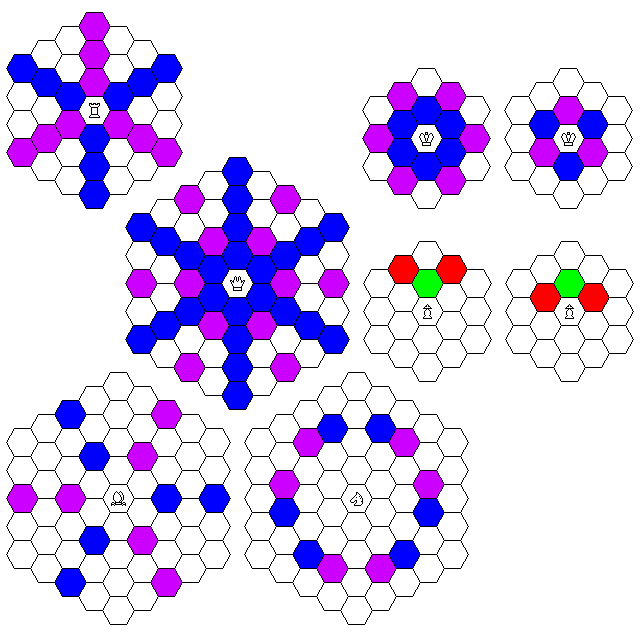
Many attempts have been made to devise a version of Chess that can be played on a board composed of hexagons instead of squares.
There are two main reasons why this would be considered.
One obvious one is to permit a game for three players to be devised which does not require a board that is stretched and distorted.
But another reason, perhaps less obvious, but more fundamental, is that a square adjoins four neighboring squares in an identical fashion, while a hexagon adjoins six neighboring hexagons in an identical fashion. Thus, a greater number of different directions are identical on a hexagonal board, and thus it might be seen as a closer approximation to the real world, in which every direction is the same.
This is the reason why virtually all board wargames are based on a hexagonal grid.
The diagram below shows one general class of moves for the pieces on a board composed of hexagons, largely constructed on the basis of a strict geometrical analogy with the moves of pieces in conventional Chess, and then shows how this analogy has been relaxed somewhat in some variants for the King, the Pawn, or both:

For most pieces, the hexagons to which they can move may be colored either blue or purple; this is simply done to make the directions in which they may move more distinctive. In the case of a Pawn, a green hexagon indicates where the Pawn can move, but not capture, and a red hexagon is one on which the Pawn can capture, but to which it cannot move without capturing.
In the upper left, we see the simplest move, that of the Rook. It moves in a straight line in the six directions defined by the hexagons adjacent to its starting hexagon.
At the bottom left, we see the move of the Bishop. It moves in directions that are halfway between pairs of adjacent directions in which the Rook can move. Note that a single step by a Bishop on the square grid produces the same displacement as two single steps by a Rook at right angles. Here, a Rook taking two steps in different directions has more choices; if it partly doubles back on itself, the result is one Rook step in a different direction; if it partly continues away from its original position, the result is a single Bishop step.
As in conventional Chess, a Bishop may only reach some of the squares of the board, but instead of the squares being divided by this into two colors, they are divided into three colors.
Near the middle, we see the Queen, which combines the move of the Rook and the Bishop.
At the bottom right, we see the move of the Knight. As in conventional Chess, the displacement of its move is the same as that of one Rook step followed by one outwards Bishop step. In two moves, it can attain a displacement corresponding to a single Rook step, so as in conventional Chess, it can reach any square on the board.
In the upper right portion of the image, we see two pairs of diagrams, one showing two possible sets of moves for the King, and below it another showing two possible sets of moves for the Pawn. For now, we will begin by considering only the diagram on the left of each pair.
As in conventional Chess, the King is shown as moving either a single step as a Rook, or a single step as a Bishop.
As in conventional Chess, the Pawn is shown as moving one step forwards as a Rook, and capturing one step forwards as a Bishop.
One form of Hexagonal Chess which uses these moves for all the pieces, the ones which follow a strict analogy with the moves of conventional Chess, was devised by one I. G. Shafran in 1953. Its board and initial array are shown below:
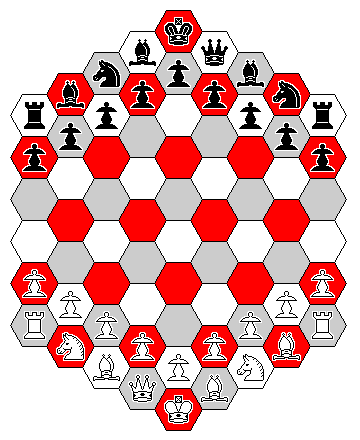
In this game, the Pawns on the edges of the board do not have a double-step first move; the next two inwards on each side do have such a move, and the three Pawns in the middle have the choice of a double or triple step first move, all of which are subject to en passant capture.
Castling is a three-step move of the King towards the Rook on either side, which then jumps over the King, moving only two squares.
Another variant of Hexagonal Chess with these moves for the pieces was devised more recently by Dave McCooey. Also, he performed extensive computer analyses of the various endgames in Hexagonal Chess which appear on The Chess Variant Page.
Its layout is shown below,
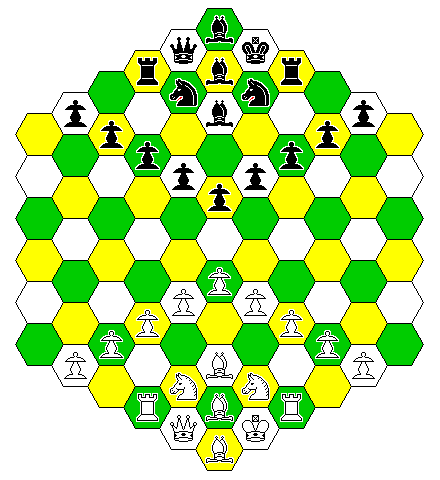
Although the layout of the board is very similar to that of Gliński's variant, to be described next, he chose a different arrangement of colors for the squares.
One criticism that can be made of the moves derived from a strict geometrical analogy with conventional Chess is that it is unrealistic for the Pawn to move forwards more rapidly than usual when it captures.
Thus, in the diagram at the top of this page showing possible moves for the pieces in Hexagonal Chess, an alternate move for the Pawn is shown on the right. Here, the Pawn still moves one step forwards. To capture, however, it still makes a move that is both forwards and to the side, as in conventional Chess, but that move is a single Rook step rather than a single Bishop step.
This is the Pawn move that is used, with the moves of all the other pieces still being those discussed previously, and used in the game devised by I. G. Shafran above, in the version of Hexagonal Chess devised by Władysław Gliński in 1936 (although apparently it was not made generally available until 1939). This form of Hexagonal Chess is the most well-known and widely-played form of Chess for the hexagonal grid at the present time. Its array is as shown below:
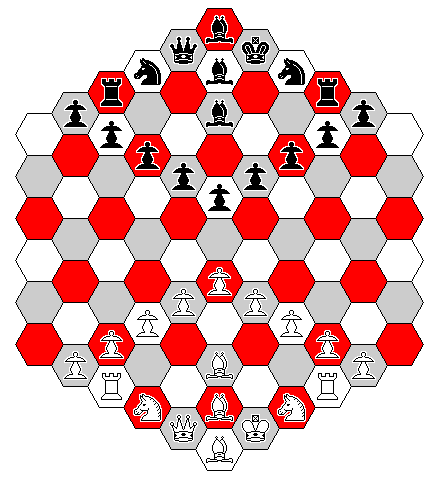
In this game, there is no castling. Any Pawn, even the ones in the center of the board, can move two spaces forwards as its first move; this is not as unreasonable as it might seem, since while the center Pawns may seem to be far forwards, the far end of the board is just as much further away from them.
When this game is played in matches or tournaments, so that points are recorded, checkmate scores the full point for the checkmating player, and stalemate wins 3/4 of the point for the player that forces stalemate, leaving 1/4 of the point for the player who was stalemated.
Another special rule of this form of Chess is that since the Pawn's capturing move may possibly allow a Pawn to move to another Pawn's starting square, the Pawn in that case may also move two squares forward as its next move; this avoids the need to keep track of the history of each Pawn.
Note that this version of Hexagonal Chess is proprietary, manufacturers of sets for this game being licensed through Hexgames Limited.
It has been estimated that this game has about a million players, chiefly concentrated in eastern Europe.
As on a hexagonal board the King's diagonal move lets it cross Rook lines, I had wondered how difficult it would be to achieve checkmate in this game. However, my worries were largely groundless. This point is addressed in Gliński's book First Theories of Hexagonal Chess; King and Rook against King is still a forced mate, just not as trivial as in conventional Chess, and usually requires that the King to be mated be forced towards one of the corners of the board.
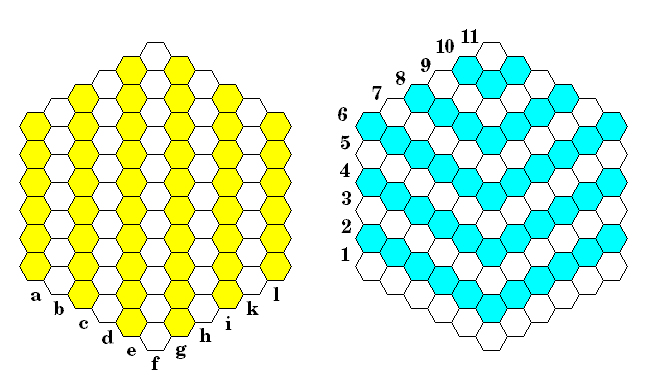
A standardized form of algebraic notation has been developed for the game, as illustrated above.
This is a reasonable response to the fact that the King is able to move across a Rook line without entering it by virtue of its ability to move one square diagonally, unlike the King on a normal square board.
Thus, in the diagram at the top of the page, an alternate move for the King is shown on the right of the one strictly analogous to its conventional move; the alternate move being one step in the six directions accessible to a Rook only.
This alternate move, along with the alternate move for the Pawn used by Gliński, was used in a form of Hexagonal Chess devised in 1929 by one H. D. Baskerville. However, while I view this set of moves as perhaps the ideal set of moves for Hexagonal Chess, the initial array of that form of Hexagonal Chess had what I view as a fatal flaw: each side had only two Bishops, and furthermore each side's two Bishops were on squares of the same color, but not the same color as the opponent's Bishops.
There is a modern commercial form of Hexagonal Chess, called Hexchess that also uses these moves. Strangely enough, each side in that game also has only two Bishops, but they are on squares of different colors, and the same two colors are used by the Bishops of all the players (two or three may play).
Thus, rather than showing the array for either of those games, what I show below is a modification of the array for Baskerville's game which gives each player three Bishops of all three colors:
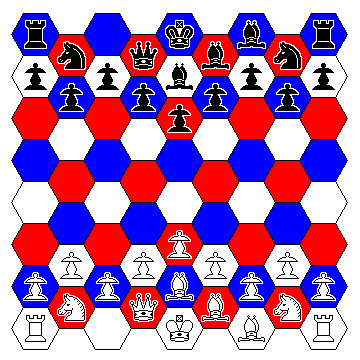
The board is less wide than Baskerville's by two files, but the spaces are colored the same way.
In his original game, Pawns had no two-step first move, and there was no castling. I propose, however, for the game on this layout, that all the Pawns except the center Pawns will have the power of a double-step on the first move, and be subject to en passant capture should they do so.
Also, I propose a rather unusual form of Castling, consisting of the King first making a Knight's move to the side to the starting square of one of its Knights as it happens, and then the Rook making a single-step diagonal move to pass it. In addition to the destination squares being empty, the Queen, for Queen's side castling, and the back-rank Bishop for castling on the opposite side, must have moved away, and their respective starting squares must be vacant, although a piece in such a position would not obstruct a normal Knight's move.
Drawing inspiration from the variants of Gliński and Dave McCooey, as well as from Capablanca Chess, Cesc Sasal i Lasaosa devised a hexagonal chess variant called C'Escacs, with three additional pieces, and a modified Pawn move.
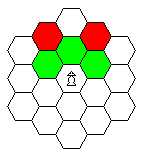
In addition to moving directly forwards, the Pawn may also move, but not capture, in the two other orthogonal directions that are partly forwards.
Also, the Pawn has a double or triple step first move.
The double or triple step first move means that this game allows en passant capture.
As well, the additional directions of Pawn movement allow another special capturing move, called the scornful Pawn capture. This move is not the direct analogue of en passant capture; instead, its purpose is to reproduce another aspect of the normal game of Chess. Where two Pawns of opposite color face each other in adjacent squares on the same file, if one uses the additional forwards Pawn move at 60 degrees to the vertical to go around the other Pawn, by which it would be blocked if that additional move were not available, then the other Pawn, on the next move, may capture it by moving to the square it occupies, even though that move is a move of the same type, which can normally only be made to move and not to capture.
Thus, unlike a double (or, in this case, also triple) step move, the goal is not to prevent the new forwards Pawn move from being used to evade capture, but instead to prevent it from being used to escape from being blocked by an opposing Pawn.
The layout for this game is arranged as follows:
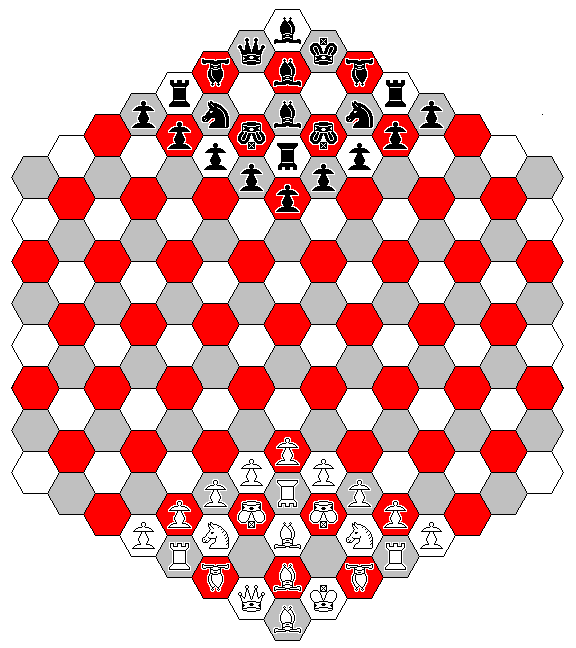
The three additional pieces are the Almogavar, the Pegasus, and the Dragon.
The Dragon combines the moves of the Rook and the Knight, being the hexagonal version of the piece for which I usually use the name Empress, and which was called the Chancellor in Capablanca Chess. Thus, it is represented in the diagaram by an upside-down Rook.
The Pegasus combines the moves of the Bishop and the Knight, being the hexagonal version of the piece for which I usually use the name Princess, and which was called the Cardinal in Capablanca Chess. Thus, it is represented in the diagram by an upside-down Bishop.
The Almogavar moves either one space diagonally, or two spaces orthogonally. This is a very interesting move on the hexagonal board.
A piece with such a move on the conventional square board would be confined to a single color. On the hexagonal board, however, while a diagonal move on one space restricts a piece to one of the three colors, an orthogonal move of two spaces would instead restrict a piece to one of four different classes of hexagon; therefore, a piece combining both moves can move to any hexagon on the board.Originally, the place of the Almogavar on the board of C'Escacs was instead occupied by the Prince; this is the hexagonal version of the piece I usually call the Man; it has the same move as the King, but is an ordinary piece the capture of which has no special significance. Thus, the Almogavar is represented, in the diagram above, by an upside-down King.
Also, there was a variant, C'Escacs-L, where the Queen-side Almogavar was replaced by a Lion. This piece had the combined move of a Prince and a Knight. (This seems to have been a variant of the original game, and so the King-side Almogavar would have instead been a Prince.)
Also, Castling is not permitted in this game; instead, once during the game, the King is allowed to make a Knight's move.
To permit the full versatility of a hexagonal board to be used,
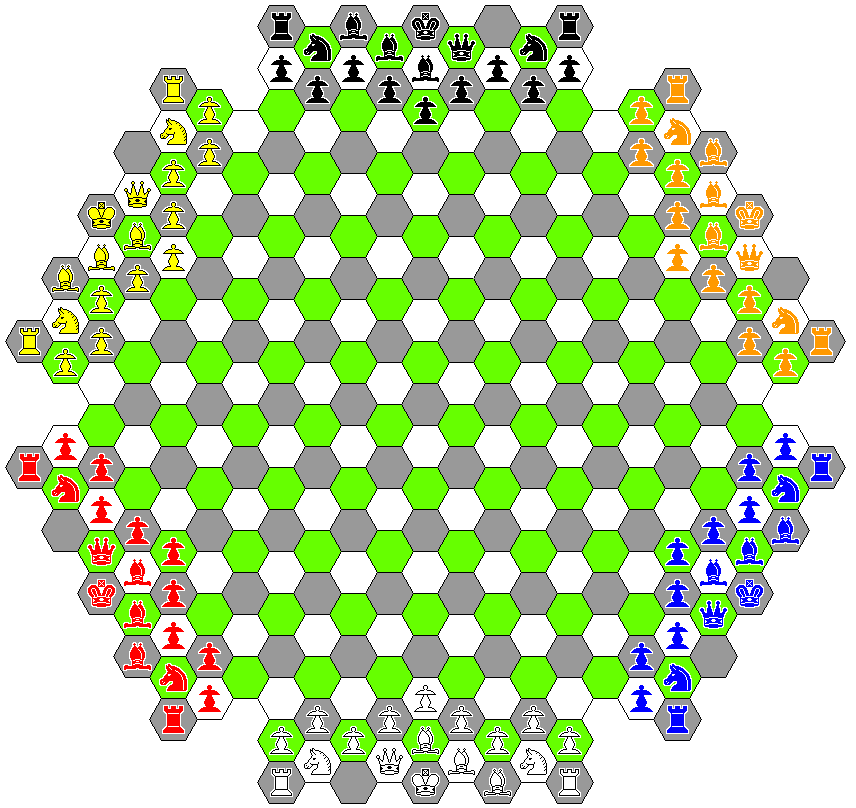
the layout above shows an arrangement that could be used by two, three, four, or six players. Three players would use pieces in the positions shown for the white, yellow, and orange pieces, but with black pieces replacing the yellow ones, and red pieces replacing the orange ones. In the case of two players, the white and black pieces would be used, and the arrangement of the black pieces would be reflected. In the case of four players, the white, black, yellow, and blue pieces would be used, with the white and black arrays being reflected in their arrangement.
For a version of Hexagonal Chess with the Baskerville moves and three Bishops of different colors on each side that allows a more conventional type of Castling, this board and array, intermediate between those of Shafran and Gliński, might be considered:
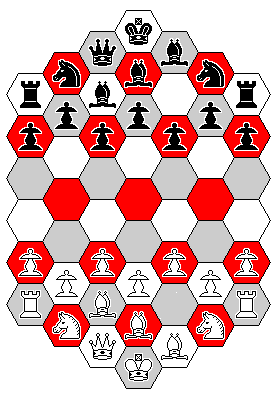
On this board, castling would be a move that pointed slightly forwards, and it would be similar to Kingside castling in either direction. Note that there is one empty space in both of the arrays shown. An extra piece could be added to these arrays; one possibility might be a hexagonal version of the Tiger from previous pages, a piece that moves like a Bishop, but captures like a Knight.
Also, the array could be expanded by a pawn at each side, so that the board could be expanded just a little, making it pleasingly hexagonal in shape:
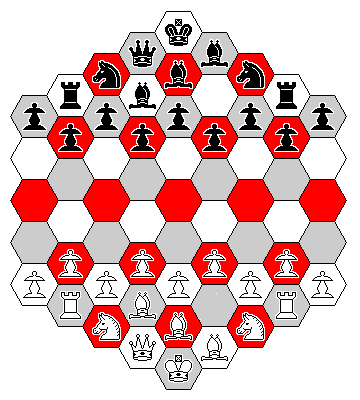
Of course, this board, of 61 hexagons, would be too small for a three-player game using this array. The board of 91 hexagons would be somewhat cramped, and the next larger size of 127 hexagons would probably be more appropriate.
On an earlier page, I showed how the square board might be distorted by a smaller amount than required to permit three player Chess for a version of five-player Chess. A lattice of hexagons does not require as severe a distortion to allow a game for five players, and it also can be warped so as to allow a game for seven players with only gentle stretching:
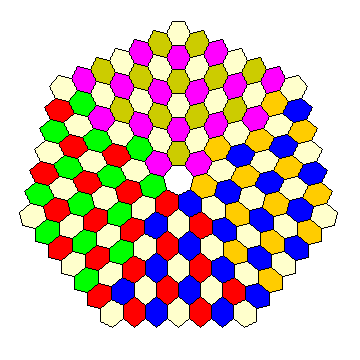
The array in my version of Hexagonal Chess just above could be applied to the corners of this array, with the addition of two extra Pawns at each end, as done for the second version on a board that is hexagonal in overall shape, so that the Rooks would not have an opening to the board at the beginning, for two players who would wish to play Hexagonal Chess in warped space. The board would have to be larger for seven players, while for two players it could be smaller.
It might be noted that the Chess Variant Pages contain a game called Sunflower Chess, by one Graham C. Neatham, which applies a somewhat more severe distortion to the wedges of hexagons, fitting eight of them around the center. But the arrangement also differs from the one above in offsetting the component triangles of hexagons by one space so that the arrangement has a spiral structure.
Instead of simply placing seven arrays for some version of Hexagonal Chess on the board, however, one could take an existing game for seven players:
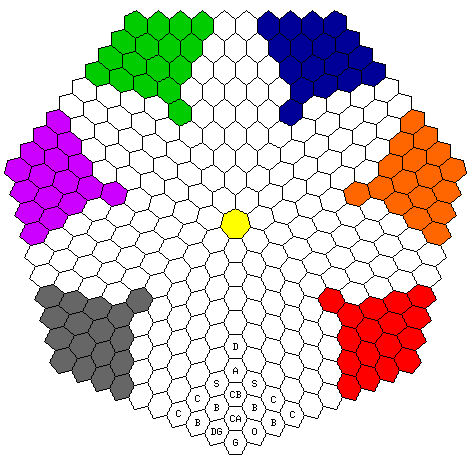
and give all the pieces the hexagonal analogs of their moves in the traditional Chinese seven-player game of Warring States Chess!
That is:
D: Diplomat, cannot capture, be captured, or give check; moves as Queen. A: Archer, moves 4 spaces as a Queen. S: Swordsman, moves one space diagonally. CB: Crossbowman, moves 5 spaces as a Queen. B: Broadswordsman, moves one space orthogonally. CA: moves along rook lines, captures along rook lines with one intervening piece, friendly or enemy, as a screen. DG: Deputy-General, moves as Rook. G: General, moves as Queen. O: Officer, moves as Bishop.
C: Moves one space orthogonally, then changes course by 30 degrees and moves three spaces diagonally; this is the only piece that doesn't have a move with an immediate hexagonal analog which has already been shown in the diagram of moves at the top of this page.
A player is eliminated when 11 of his pieces other than the General, or his General, is captured. A player wins when he captures either 30 pieces that are not Generals, or two Generals.
Note that going around the board clockwise, Blue becomes Green, which becomes Brown, then Orange, and then Red, and after that Purple, and finally Blue again after two circuits of the board, while the cream-colored hexagons maintain their color consistently. Thus, there are three colors of hexagon locally, and yet only two colors globally.